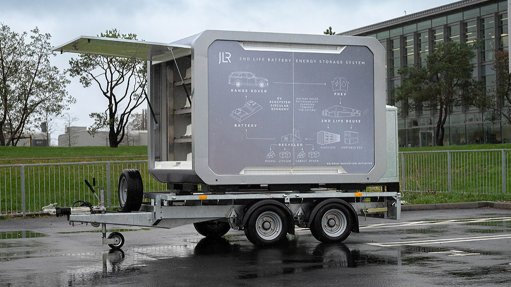Smaller Scale Gtl – The New Business Opportunity
This article has been supplied as a media statement and is not written by Creamer Media. It may be available only for a limited time on this website.
Company Announcement - Velocys commercial director Jeff McDaniel has lent his voice to the movement for smaller scale gas-to-liquids technology, saying it is able to provide both asset owners and mid-stream operators with significant financial opportunities. This follows the release of the Global Gas-to-Liquid Market 2014-2018 research report in August, which found that one of the main drivers in the GTL market is the growing need to reduce gas flaring from refineries. McDaniel makes specific reference to the North American gas market’s “radical revolution”, driven primarily by the development of shale gas. “With this dramatic growth comes a number of challenges for gas owners and operators.
Gas, in many ways, is a great fuel, but it presents significant challenges and costs to get it to market. The transition from an age of oil to an age of gas means these challenges will have to be met and infrastructure developed to transport the product,” McDaniel said. He said that while asset owners wanted to get as high a price as possible in the shortest time period, many of the newer gas fields were located in remote parts of the world that traditionally had not produced gas. “The problem is one of infrastructure; that is, infrastructure needed to access these reserves and the deliver the gas from the fields to the end customer has not yet been built.” A good example, he said, was the U.S.’s biggest shale gas field at Marcellus. At this field, processing plants had reached a bottle-neck, in that there were not enough facilities to process the gas or enough pipelines to deliver the required volumes.
It was for this reason that he moots smaller scale GTL facilities at a gas processing plant. “The site could avoid the constraints and limitations of having no spare gas pipeline capacity by changing the gas into an easily transportable liquid and enable more gas to be processed from the region.” One of the great advantages of these facilities is that they require considerably less capital and much smaller gas reserves to be economically and practically viable. In addition, they are able to be deployed in remote locations and are easier to permit, supply and operate. “Conventional GTL technology is only economically viable for plants that have access to enough gas to produce in excess of 30 000 barrels per day (bpd) of liquid fuels. Given the large volumes of gas required, only 6% of the world’s known gas fields can sustain a mega-scale plant and only a handful of oil majors can contemplate building one. “However smaller scale GTL, using microchannel technology, is designed to operate both efficiently and economically when producing between 1 500 and 15 000 bpd of liquid fuel, unlocking more than half the remaining gas fields that conventional GTL simply can’t exploit and putting GTL within reach of many more developers.”
He said without the smaller scale GTL option, the owner would have to secure the field, test it and prove it out and then convert it to dollars as fast as possible. “Many fields don’t have the infrastructure, in other words the pipeline, to be able to do that, so have to build it.” Fortunately smaller scale GTL was fast becoming a “commercial reality”, he said, particularly as it was alleviating many environmental concerns through its reduction or mitigation of flaring. This fact itself also gave rise to economic opportunity.
“Associated gas, which is produced along with oil, is a potentially valuable resource but is often disposed of by the environmentally damaging practice of flaring because there is no practical and economical method available to transport the gas to market. “Smaller scale GTL creates value from the gas that would otherwise have been flared, and in some cases unlocks constrained oil production, with a potentially large upside in revenues.
“Natural gas in the US sells for roughly $4 per million btu, whereas ultra-clean diesel, the fuel produced by GTL, sells for roughly $22 per million btu. That is the fundamental economic driver for GTL – it takes a low cost gas and makes it into a much more valuable product.” Investing in the shale gas industry is one of the key topics on the agenda at this year’s Oil Council World Assembly (http://www.oilcouncil.com/event/weca/agenda), taking place at the Lancaster Hotel in London, from November 17 to 18. Every year, the World Assembly welcomes more than 1000 oil and gas companies, financiers and investors who are looking to invest billions of dollars. As the world’s largest business network for oil and gas, leaders from the upstream, midstream, downstream, finance, investment and petroleum services sectors attend the World Assembly.
Comments
Press Office
Announcements
What's On
Subscribe to improve your user experience...
Option 1 (equivalent of R125 a month):
Receive a weekly copy of Creamer Media's Engineering News & Mining Weekly magazine
(print copy for those in South Africa and e-magazine for those outside of South Africa)
Receive daily email newsletters
Access to full search results
Access archive of magazine back copies
Access to Projects in Progress
Access to ONE Research Report of your choice in PDF format
Option 2 (equivalent of R375 a month):
All benefits from Option 1
PLUS
Access to Creamer Media's Research Channel Africa for ALL Research Reports, in PDF format, on various industrial and mining sectors
including Electricity; Water; Energy Transition; Hydrogen; Roads, Rail and Ports; Coal; Gold; Platinum; Battery Metals; etc.
Already a subscriber?
Forgotten your password?
Receive weekly copy of Creamer Media's Engineering News & Mining Weekly magazine (print copy for those in South Africa and e-magazine for those outside of South Africa)
➕
Recieve daily email newsletters
➕
Access to full search results
➕
Access archive of magazine back copies
➕
Access to Projects in Progress
➕
Access to ONE Research Report of your choice in PDF format
RESEARCH CHANNEL AFRICA
R4500 (equivalent of R375 a month)
SUBSCRIBEAll benefits from Option 1
➕
Access to Creamer Media's Research Channel Africa for ALL Research Reports on various industrial and mining sectors, in PDF format, including on:
Electricity
➕
Water
➕
Energy Transition
➕
Hydrogen
➕
Roads, Rail and Ports
➕
Coal
➕
Gold
➕
Platinum
➕
Battery Metals
➕
etc.
Receive all benefits from Option 1 or Option 2 delivered to numerous people at your company
➕
Multiple User names and Passwords for simultaneous log-ins
➕
Intranet integration access to all in your organisation


















